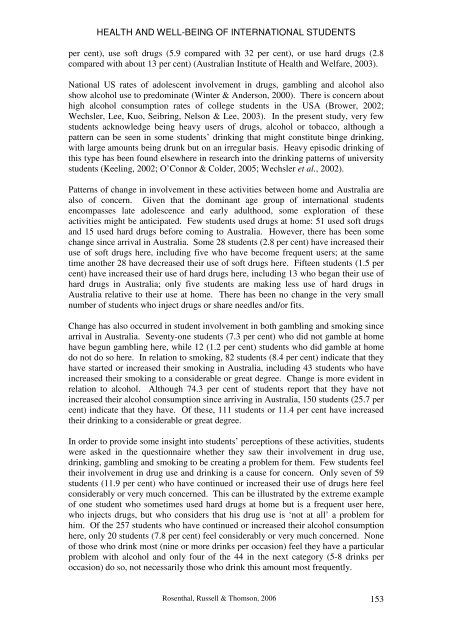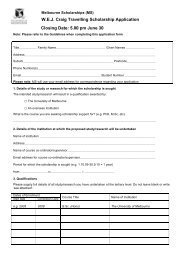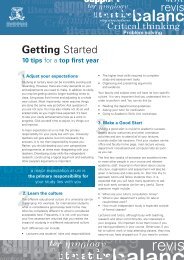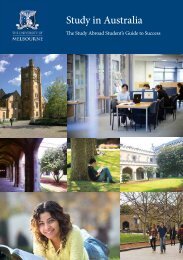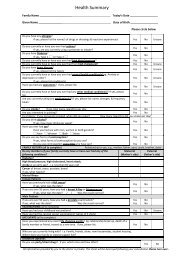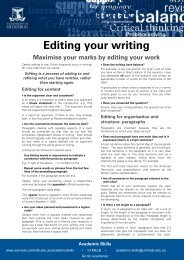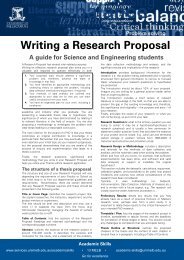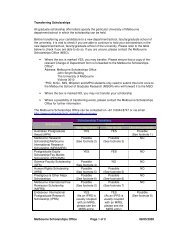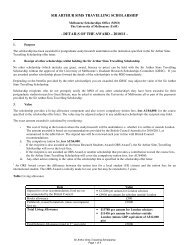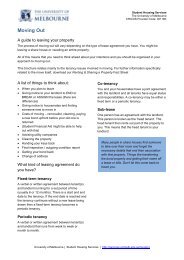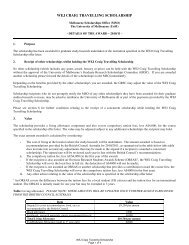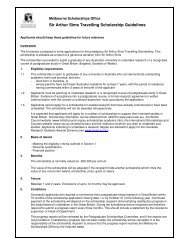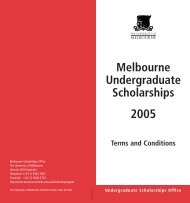a growing experience - Student Services - University of Melbourne
a growing experience - Student Services - University of Melbourne
a growing experience - Student Services - University of Melbourne
You also want an ePaper? Increase the reach of your titles
YUMPU automatically turns print PDFs into web optimized ePapers that Google loves.
HEALTH AND WELL-BEING OF INTERNATIONAL STUDENTSper cent), use s<strong>of</strong>t drugs (5.9 compared with 32 per cent), or use hard drugs (2.8compared with about 13 per cent) (Australian Institute <strong>of</strong> Health and Welfare, 2003).National US rates <strong>of</strong> adolescent involvement in drugs, gambling and alcohol alsoshow alcohol use to predominate (Winter & Anderson, 2000). There is concern abouthigh alcohol consumption rates <strong>of</strong> college students in the USA (Brower, 2002;Wechsler, Lee, Kuo, Seibring, Nelson & Lee, 2003). In the present study, very fewstudents acknowledge being heavy users <strong>of</strong> drugs, alcohol or tobacco, although apattern can be seen in some students’ drinking that might constitute binge drinking,with large amounts being drunk but on an irregular basis. Heavy episodic drinking <strong>of</strong>this type has been found elsewhere in research into the drinking patterns <strong>of</strong> universitystudents (Keeling, 2002; O’Connor & Colder, 2005; Wechsler et al., 2002).Patterns <strong>of</strong> change in involvement in these activities between home and Australia arealso <strong>of</strong> concern. Given that the dominant age group <strong>of</strong> international studentsencompasses late adolescence and early adulthood, some exploration <strong>of</strong> theseactivities might be anticipated. Few students used drugs at home: 51 used s<strong>of</strong>t drugsand 15 used hard drugs before coming to Australia. However, there has been somechange since arrival in Australia. Some 28 students (2.8 per cent) have increased theiruse <strong>of</strong> s<strong>of</strong>t drugs here, including five who have become frequent users; at the sametime another 28 have decreased their use <strong>of</strong> s<strong>of</strong>t drugs here. Fifteen students (1.5 percent) have increased their use <strong>of</strong> hard drugs here, including 13 who began their use <strong>of</strong>hard drugs in Australia; only five students are making less use <strong>of</strong> hard drugs inAustralia relative to their use at home. There has been no change in the very smallnumber <strong>of</strong> students who inject drugs or share needles and/or fits.Change has also occurred in student involvement in both gambling and smoking sincearrival in Australia. Seventy-one students (7.3 per cent) who did not gamble at homehave begun gambling here, while 12 (1.2 per cent) students who did gamble at homedo not do so here. In relation to smoking, 82 students (8.4 per cent) indicate that theyhave started or increased their smoking in Australia, including 43 students who haveincreased their smoking to a considerable or great degree. Change is more evident inrelation to alcohol. Although 74.3 per cent <strong>of</strong> students report that they have notincreased their alcohol consumption since arriving in Australia, 150 students (25.7 percent) indicate that they have. Of these, 111 students or 11.4 per cent have increasedtheir drinking to a considerable or great degree.In order to provide some insight into students’ perceptions <strong>of</strong> these activities, studentswere asked in the questionnaire whether they saw their involvement in drug use,drinking, gambling and smoking to be creating a problem for them. Few students feeltheir involvement in drug use and drinking is a cause for concern. Only seven <strong>of</strong> 59students (11.9 per cent) who have continued or increased their use <strong>of</strong> drugs here feelconsiderably or very much concerned. This can be illustrated by the extreme example<strong>of</strong> one student who sometimes used hard drugs at home but is a frequent user here,who injects drugs, but who considers that his drug use is ‘not at all’ a problem forhim. Of the 257 students who have continued or increased their alcohol consumptionhere, only 20 students (7.8 per cent) feel considerably or very much concerned. None<strong>of</strong> those who drink most (nine or more drinks per occasion) feel they have a particularproblem with alcohol and only four <strong>of</strong> the 44 in the next category (5-8 drinks peroccasion) do so, not necessarily those who drink this amount most frequently.Rosenthal, Russell & Thomson, 2006 153


